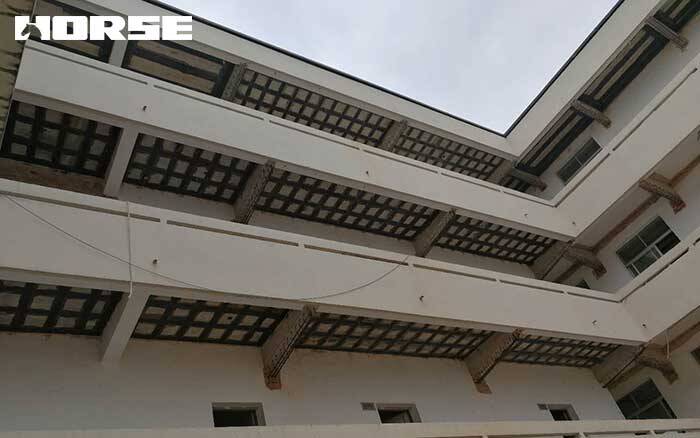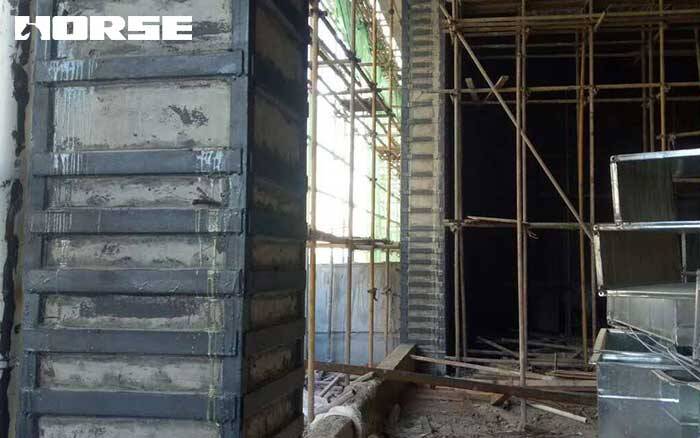Solutions
Horse Construction offers full range of structural strengthening materials with technical supports, documentation supports, products supports, project supports.
structural strengthening

1 Basic principles of structural strengthening technology
1.1 Stress characteristics of structural strengthening
The stress of the strengthening member is different from that of the original structural member, and most of the strengthening methods are secondary stress. It can be seen from Hooke's law that only when the structural members that are added later are compressed or stretched and deformed, the newly added material generates stress before working with the original structural members. Therefore, during the subsequent loading process of the reinforced member, the stress of the newly added material always lags the accumulated stress of the original structural member. When the original component reaches the stress limit, the material stress of the newly added part is relatively low, and it is easy to damage one by one. Therefore, the strengthening design cannot be completely equivalent to the new design, and its particularity should be considered, and appropriate measures such as unloading should be taken to make the new material part and the original structural material work together to ensure the safety of the structure.
1.2 The newly added measures work together with the original components
The handling of the joint surface of the new and old structures is one of the key factors for the success or failure of the strengthening project. The joint surface mainly bears the shear and tensile forces. Therefore, whether the joint surface can bear and transmit this part of the stress is the key to the strengthening effect.
Taking the enlarged section method as an example, the main factors influencing the stress transmission of the new and old joint surfaces are the concrete strength, the roughness of the joint surface, the use of interface agents, and the setting of shear friction ribs.
2 Reasons and purposes of structural strengthening
The main reasons for structural strengthening are as follows:
(1) Defects in design and construction;
(2) Building renovation;
(3) Natural disasters, fires, etc.;
(4) Reduced structural durability;
(5) Protected building displacement.
Among them, the renovation of buildings and the treatment of structural defects are the most common problems encountered in the renovation of existing buildings. The renovation of existing buildings mainly includes: floor-building renovation, reconstruction and expansion projects, strengthening and replacement projects, relocation engineering, tilt correction engineering, structural cracking and strengthening treatment, etc.
The purpose of structural strengthening is mainly to enhance the strength, rigidity and stability of structural members, to ensure the safety of structural transformation and cracking treatment, to extend the service life of the structure, and to ensure that the structure can work reliably.
3 The basic principle of structural strengthening is
To ensure that the structural strengthening is safe and reliable, economically reasonable, and maintains quality and quantity, the following basic principles must be observed:
(1) Before structural strengthening, structural reliability assessment is required. According to the reliability report, determine the structural damage, structural material strength, strengthening design, and service life, and clarify the strengthening scope and contents.
(2) Keep the original components as much as possible to avoid or reduce dismantling.
(3) Formulate a reasonable and effective strengthening plan, shorten the strengthening cycle, and reduce the impact of strengthening on production work.
(4) Structural strengthening should adhere to the principle of first treatment and then strengthening. Factors that lead to structural defects should be eliminated first and then reinforced.
(5) Under earthquake conditions, the transfer of weak layers due to the increased local stiffness of the structure after strengthening should be avoided, and new weak layers and weak parts should be formed, affecting the seismic safety.
(6) The new and old components should ensure reliable connection, good bonding of the joint surface, ensure joint work and coordinate stress.
(7) When strengthening and unloading, effective support measures must be taken to avoid structural tilting, cracking, and collapse, and corresponding plans should be prepared.

4 Selection of structural strengthening methods
At present, the commonly used strengthening methods include enlarged section method, externally bonded steel strengthening method, pasted steel plate method, pasted FRP composite material method, added support point strengthening method, prestressed strengthening method, replacement concrete method and so on.
Each method has its own applicability, and the choice of strengthening method is crucial for the entire strengthening project. It should be noted that static strengthening is mainly to improve the bearing capacity of structural members, and it is necessary to focus on the influence of secondary stress. Seismic strengthening is mainly to improve the ductility and integrity of the structural system. The key to strengthening is the system strengthening. Generally, secondary stress is not considered.
5 Impact of unloading on structural strengthening technology
It can be seen from the stress principle of structural strengthening that the newly added part is mainly subjected to secondary stress, which affects the bearing capacity contribution of the newly added part, and there is even the risk of breaking one by one, affecting the safety of structural strengthening. Therefore, before the strengthening construction, effective unloading becomes one of the key factors for the strengthening effect. The load-bearing calculation of unloaded and reinforced structural members is still a secondary force, but when the original structure's constant and live loads are counteracted by reverse action, the structure can be calculated according to the primary force
There are two main uninstall methods, direct uninstall and indirect uninstall. Direct unloading is mainly to reduce the live load on the structure, and reinforce the construction only under the weight of the structure. Indirect unloading is to apply pre-stress reaction force externally to offset or greatly reduce the total load (including self-weight) on structural members. After the strengthening is completed, the new and old components are stressed. This kind of strengthening effect is very obvious, but the construction process is relatively complicated.
Unloading before strengthening can effectively ensure and improve the effect of structural strengthening, ensure the common stress of new and old components, and avoid the phenomenon of one by one due to stress differences.
6 Conclusion
The application of structural strengthening technology in the reconstruction project is very beneficial to the construction industry, society and the country. Therefore, it must pay attention to its related status quo and take corresponding measures to the problems existing in its development. Measures should be properly resolved to promote the development of China's construction industry.
You can find anything here you are in need of, have a trust trying on these products, you will find the big difference after that.

High strength, unidirectional carbon fiber wrap pre-saturated to form a carbon fiber reinforced polymer (CFRP) wrap used to strengthen structural concrete elements.

Prestressed carbon fiber reinforced polymer(CFRP) plate for slab, beam strengthening to increase stiffness, reduce distortion and deflection of members, reduce the cracks, avoid and stop cracking.

Modified epoxy resin structural perfusion adhesive, specifically for supporting adhesive bonded steel reinforcement